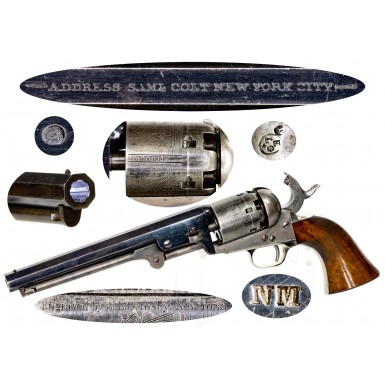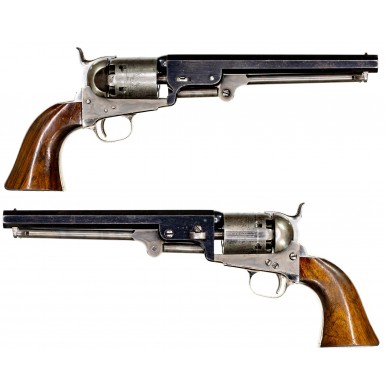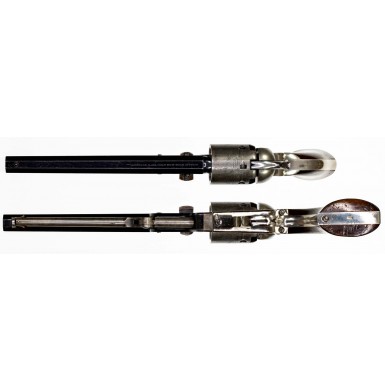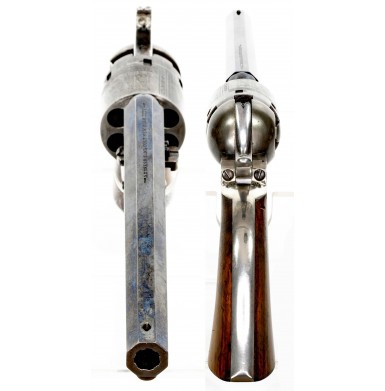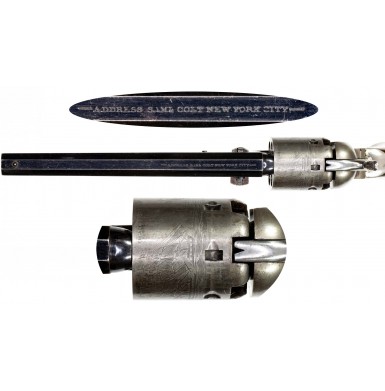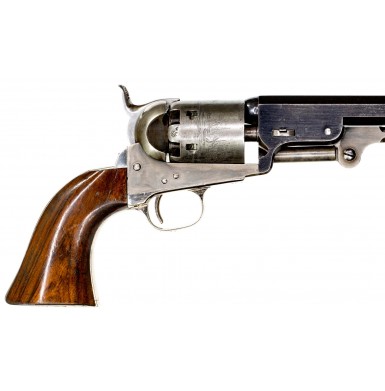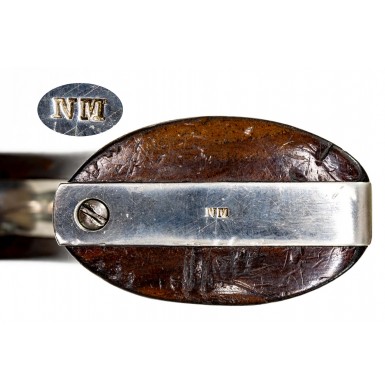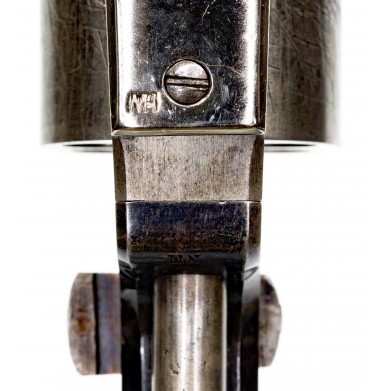Extremely Fine Belgian Brevet 2nd Model Style Colt Navy Revolver Made With Many Original Colt Parts
- Product Code: FHG-2314-SOLD
- Availability: Out Of Stock
-
$1.00
1848 was the first year when Samuel Colt claimed that his patents, designs and his Hartford manufactory all coalesced into a profitable enterprise. His journey to this stage of his life had been fraught with mishaps, economic reversals and the failure of his original Patent Arms Manufacturing Company. However, by 1848, Colt was well on his way to becoming the “American Legend” as some arms historians have referred to him.
1848 was also a year of civil unrest in Europe, as young people around the world looked to the American model of government and began to agitate for the end of the oppressive regimes that many of them were living under. For the previous two decades, groups around the world taking the monikers of “Young Italy”, “Young Ireland” and “Young Germany” to name just a few, had been organizing to help establish new democratic governments in their countries. Even the United States had its own “Young America” movement that supported the democratic movements around the world and further supported the concept of Manifest Destiny for the United States in North America, and potentially extending to Central and South America. In 1848, much of the European agitation erupted into outright rebellion. This started in France in February of 1848 and quickly spread to Sicily, the Italian States, the Austrian and Hungarian Empires, the Netherlands and many of the member states of the German Confederation. In all, some fifty European countries would become embroiled in this civil unrest that would be called the “Spring of Nations” the “Springtime of the Peoples” and the “Year of Rebellion”. In this chaotic situation, Samuel Colt saw a business opportunity. Despite the fact that his business was just starting to be truly successful in the United States and that American competitors were starting to violate his patents; Colt saw the European upheaval as a chance to enter a new market.
In the 1830s Colt had visited England and Europe to secure patent protections for designs, with mixed results. Now, with Europe on fire, he turned his gaze again across the Atlantic to secure patent protection for his products and to sell his revolvers to those willing to pay for them. As he would show in the months leading up to the Civil War, as well as for some after time the firing on Fort Sumter, Colt was interested in sales of his firearms, not in politics or ideology. He cared little if his customers were the oppressors or the oppressed, the rebels or the ruling regime. He simply wanted to sell guns.
However, Colt acted too slowly and by the time he embarked for Europe on May 2, 1849 aboard the steamer Europa, the rebellions had largely fizzled out. While some reforms were secured by the protestors, like the abolition of serfdom in Austria and Hungry, the abolishment of absolute monarchy in Denmark and establishment of a representative democratic government in the Netherlands, much of Europe returned to the previous status quo of monarchial rule. Despite the opportunities he may have missed for immediate sales, Colt continued on his course to securing European patents where he could. Always looking to the future, Colt knew that patent protection would help to prevent the manufacturers in those countries where he could obtain patents from producing arms based on his designs without paying royalties to Colt. But the patents did more than that. They also helped to protect his “brand”. He was concerned that low quality, poorly built, unlicensed copies of his guns would hurt his reputation. The average person would not necessarily know that they had not purchased a real Colt firearm, and their bad experiences with sub-standard copies would create substantial ill-will for his real products.
During the 1849 excursion Colt did achieve a licensing agreement in Austria, which granted Joseph Ganahl of Innsbruck, Austria the exclusive rights to manufacture Colt patent revolvers for five years, through August of 1854. Ganahl was one of the handful of Austrian manufacturers who held a royal appointment allowing him to manufacture firearms. Ganahl’s company was the Kaiserlich-Koeniglich Privilegierten Maschinen und Spinnen Fabrik, abbreviated as the KKP and translated as the Imperial & Royal Privileged Machinery, Textile and Spinning Factory. During the next few years Ganahl would produce his own interpretation of the Colt Dragoon, primarily for use by the Austrian Navy.
From an immediate financial standpoint, the Ganahl agreement put cash directly in Colt’s pocket. But his other efforts had longer lasting economic ramifications. In England Colt received British Patent #12668/1849 for his revolver design, with the patent drawings showing one of his early Dragoon design variants that still used the side-mounted loading lever from the latter part of Paterson production. The following year, in March 1850, Colt was granted Belgian Patent #1217 for his revolver design concepts. In both cases, the most important salient features that were protected was the actuation of cylinder rotation by the cocking of the hammer, which also activated the bolt stop which locked the cylinder in place. 1850 was a busy year for Colt as he was now actively protecting his rights around the world, both via lawsuits in America and by securing patents around the globe.
It was 1851, the year of the Great Exhibition (often referred to as the Crystal Palace Exhibition) in London, that made Colt a world renowned name. The success of the arms that he displayed was reported in newspapers in England, Europe and America and likely in all corners of the globe. Some enterprising Belgian gun makers even displayed Colt “Brevete” revolvers. “Brevete” was the French word for “Patented”. One of the most popular guns displayed by Colt was his new belt model revolver which the world would come to know as the Colt Model 1851 Navy. This gun would become of the most successful of the Colt percussion revolver designs, second only to the 1849 Pocket Model, in terms of length of production and numbers produced. This would be the gun that would become most popular with the Belgian makers who would produce copies of Colt revolvers for the next few decades, both licensed legal guns and illegally produced unlicensed counterfeits.
In an attempt to control the flow of legally and illegally made “Colt” revolvers from the numerous arms makers of Liège a Belgian representative was engaged by Colt to monitor the flow of arms through the Liège proof house. M Devos Sera was responsible for inspecting the revolvers that were flowing through the proof house and collecting a 10-franc royalty from those that utilized Colt’s protected designs and were also up to the standards of Colt production. As noted, Colt had a vested interest in making sure that any guns produced under his patents be quality arms. It was Mr. Sera’s job to collect the royalties from the guns that passed his quality control inspections and was able to confiscate those that were made without a license if the guns were not good enough or if the maker refused to pay the royalty. After acceptance, and royalty payment, Sera was to mark the barrels of the guns with a two-line stamp that either read COLT / BREVETE or COLT / PATENT. It is believed that the ones marked “Brevete” were for sale in Europe while the ones marked “Patent” were destined for English speaking countries.
The study of the Belgian-made Colt “Brevete” revolvers is a confusing and complicated web of makers, suppliers and guns that range from poor quality, illegally-made copies to licensed products that were of nearly the same high quality as Colt’s Hartford-made guns themselves. The most in-depth study to date was undertaken by Ron Paxton & Roy Marcot in their book Colt Brevete Revolvers, which I have relied upon heavily in writing the background information on the Colt Brevete. The authors note that despite their years of research and examination of extant examples, there still remains much about these arms and their production that is unknown and may never be known.
A number of major Liège makers produced quality, legal copies of Colt revolvers, including N. Gilon, P.J. Fagard, L. Ghaye and Auguste Francotte. Sometimes these guns are marked by their maker in obvious ways, like the N. Gilon’s name on the barrel or face of the cylinder or P.J. Fagard’s name inside the triggerguard. More often the markings are less obvious, if they are present at all. Sometimes only initials are present and sometimes no marks are present at all. The presence of absence of the marks does not necessarily help a collector to determine who actually made the gun, or if the maker produced all of the parts in the gun themselves. Much like the English gun trade in Birmingham, Liège was cottage industry based manufacturing system. While some very large makers like Francotte operated in a more traditional “factory” setting, many more were small makers working on a piece-work basis. That meant that specialized craftsmen were producing various parts which were then gathered and assembled by other small makers or even the largest makers. To further muddy the waters, Colt soon realized that he could provide Hartford-made parts to the Liège trade and could make money both by collecting royalties and by selling gun parts. Major Hartford-made components that appear from time to time in Liège-made Brevete revolvers include barrels, frames and cylinders. The cylinders are of interest as they are the only ones that appear in Colt Navy Brevete revolvers with the real Ormsby engraved Naval Engagement scene. Other Brevete 1851 Navy revolvers have a wide variety of cylinder scenes, with Paxton & Marcot depicting ten known variations. They also notes that these scenes were often hand engraved rather than roll engraved as were the Colt scenes, which means even within the basic design there is great variation.
Offered here is really wonderful condition example of a Colt Brevete Model 1851 Navy Revolver produced by an unknown Liège maker who used a number of early production Colt made parts. Research has suggested that the majority of the Colt M1851 Navy Brevete revolvers encountered today are essentially copies of early 4th model Navy revolvers, which start to appear in Colt production around serial number 85,000. This means that most of these Colt Brevete revolvers based upon the 4th model features, could not have been produced prior to sometime in 1858, which is when the serial number 85,000 was reached. However, a smaller subset of Colt Brevete Navy revolvers exist that are based more upon the 1st and 2nd model Navy revolvers. These guns sometimes incorporate Colt-made parts, and this raises an interesting question; was Colt selling the early pattern parts just for money and ensure the quality of the revolvers produced by the Belgian trade OR was he selling parts that were no longer of use to his current production and this was an effective way recoup his investment in parts that were otherwise essentially useless to the company.
The revolver offered here is one of the Liège-made Brevete Navy Revolvers that is based upon the earlier 2nd model design, and also incorporates a number of early production Colt manufactured components. The Colt components include the barrel, loading lever, cylinder, frame and backstrap. The barrel has an early Colt barrel address that reads:
- ADDRESS SAML COLT NEW YORK CITY -
This same address is shown in Robert Jordan & Don Geri’s exhaustive study of Colt Navy revolvers in the book Colt 1851 and 1861 Navies & Conversions on an early production 1st Model Navy. The salient features that indicate both the address on this barrel and the address on the gun shown in the book came from the same die are the broken left angled upright in the letter “A” in the name “SAML”. The example depicted is on gun number 588. By way of comparison by the time #3013 was produced, a 2nd Model Navy, a new die was in use and the broken letter was no longer an issue. As the barrel web has the traditional wedge location, with the slot under the screw, we know it is a 2nd Model barrel with the earliest barrel address, suggesting the barrel itself was produced between about Colt serial #800 and #3000. This places the barrel’s production in mid-1850 to early 1851. The barrel also incorporates the thin, 2nd Model type loading lever catch and the early loading lever design with the pivot screw entering from the right side of the lever, rather than the right side. The pivot screw was relocated to the left side of the lever during middle 3rd Model production, somewhere in the middle of the 3X,XXX range of numbers, with the screw appearing randomly on either side through most of that serial number range and finally becoming uniform on the left side around the 39,XXX serial number range.
The cylinder is a very early Colt produced cylinder and the early production is identified in two ways; by the use of the early style ratchet on the rear of the cylinder and by the presence of the WL Ormsby signature in the roll engraved naval battle scene. The Type 1 Colt cylinder ratchet was cut with essentially straight lines, resulting in the ratchet cuts having a very triangular profile with a straight angle, rather than the curved, “ski ramp” type cut on the Type 2 cylinder ratchets. The Type 1 ratchet shape was phases out between about serial numbers 13,500 and 19,000 with the Type 2 curved ratchet cut being standard after that point. Thus, by the end of 1853 the Type 1 ratchet cut was essentially no longer in use. Additionally, the roll engraved naval battle scene retains a crisp and clear WL Ormsby signature. This signature was worn away from the scene by the upper 7X,XXX range, essentially disappearing by sometime in 1857. The scene is also rolled much deeper than on later production guns, again indicating a fresh roll die that had not seen heavy use and wear.
The frame and backstrap are both Colt factory parts and have Colt factory inspection marks on them. The face of the recoil shield is stamped with the inspector letter H and the backstrap is marked with the inspector letter R. The frame uses the typical 2nd Model type cylinder arbor as well.
The gun remains in exceptional condition and is entirely original and correct in every way. The revolver has a minimum of external markings, as is typical of a Belgian Brevete and like so many is not serial numbered. As noted, the Colt manufactured barrel has the earliest Colt factory roll engraved barrel address. The cylinder is deeply rolled with the standard Colt naval battle scene and is clearly marked ENGAGED 16 MAY 1843 along the leading edge. The usual roll engraved box is on the side of the cylinder that reads COLT’S PATENT No with no serial number following the imprinted legend. Underneath this box the cylinder is crisply marked
Engraved by W.L. Ormsby. New York.
This is a mark only found on early Colt cylinders produced prior to 1857 and even then, is often worn away due to how lightly it was rolled. This signature is deep, clear and crisp. The cylinder also has a traditional Liège proof mark of an E/LG/* within an oval. A tiny maker’s mark is also present on the cylinder, a tiny, raised capital D in a depressed circle. This same mark is also found on the left side of the barrel, forward of the forcing cone. The only other external markings are the capital letters NM on the lower web of the barrel and on the butt and a conjoined HW or possibly MH on the triggerguard. The meaning of these marks are not known, but a very similar configuration Brevete Navy is pictured on page 196 of the Marcot & Paxton book with the NM marking on the bottom of the barrel web, a thin 2nd Model loading lever catch and a loading lever pivot screw that enters from the right side of the lever. As noted, the gun has no serial number, but does include the traditional Liège style file slash assembly marks. In this case mark is three slashes, which appear on essentially every major part from the cylinder and arbor pin to the frame, grip frame and grip itself.
The as noted gun follows the basic form of a “Second Model” Colt Navy revolver and incorporates a number of Colt produced components. In fact, the only parts that are clearly of Belgian production are the wedge and hammer, although it is likely that many of the small parts, internals and screws originated in Liège. The .36 caliber gun has a 7 ½” octagonal barrel, a 1 11/16” six-shot cylinder, small brass triggerguard and thin, “Slim-Jim” style one-piece grips. The profile and overall appearance of the revolver combined with the use of actual Colt factory parts and markings would easily allow the gun to be mistaken for an actual Colt-made gun. Like the Colt produced Navy, the revolver has a blued barrel and cylinder and a color casehardened frame and loading lever. Unlike a Colt, it has a nickel-plated brass triggerguard, backstrap and gripstrap, which is the only obvious departure from Colt finish practices. The one-piece grip is varnished figured walnut with a lighter brown tone that is very attractive.
The revolver remains in about NEAR EXCELLENT condition and retain most of its original finish. The barrel retains about 90%+ of its original bright blued finish with some thinning, fading and minor loss due to handling and use. Most of the loss is along the sharp edges of the barrel flats, the contact points and around the muzzle. The cylinder retains some strong traces of blue but has thinned and worn to a medium pewter gray patina with streaky patches of thin blue here and there. The cylinder retains 90%+ of the deeply and crisply roll engraved naval battle scene, along with a clear WL Ormsby signature. All of the markings in the metal of the gun are extremely clear, crisp and fully legible as well. The frame retains about 70%+ of the original color casehardened finish. Unlike the Colt case coloring the colors are much more muted and significantly less vibrant with more of a smoky gray color and lightly mottled blues and purples. The case colors look more like the tones you would expect to see on a London-made Colt Navy after some fading and dulling and do not have, and likely never had, the vibrance of American case colors. The loading lever retains a similar amount of its muted case coloring, with most of the fading and loss at the end. The brass triggerguard and gripstrap retain nearly all of their nickel plated finish. I cannot determine when the nickel was applied, if it was at the time of production or later. The nickel is thick and has apparent age, suggesting that it is from the period of use as more recent nickel plating would be much thinner. The metal is entirely smooth with no pitting present. There is some freckled light surface oxidation shot through the blued finish and some freckled oxidation is present on the face of the cylinder and around the muzzle as well. The cone recesses of the cylinder show some light oxidation and wear from the caustic cap flash. The cones (nipples) all appear to be original and remain very crisp, showing only light use. The locations of the safety pins on the rear face of the cylinder are all still visible, although only the remnants of three battered pins remain, with the other three having only the circular shadow of their original location remaining. The revolver is in fine mechanical condition and remains extremely tight. The revolver times, indexes and locks up exactly as it should. The loading lever operates smoothly as well and locks securely into place when it is not in use. The bore is in VERY FINE condition and remains mostly bright with some scattered oxidation. The bore retains very crisp and deep 7-groove rifling which shows obvious gain twist, with the slow rifling at the breech increasing in pitch towards the muzzle. The one-piece walnut grip is in VERY FINE condition as well and retains nearly all of its original finish. The grip is solid and free of any breaks, cracks or repairs and remains very crisp. The grip has some very nice figure to the wood and is very attractive. It shows only some very lightly scattered handling marks. The high condition of the grip matches the balance of the gun very well.
Overall, this is a really wonderful example of a relatively scarce and very interesting Liège-made Colt Model 1851 Navy Brevete Revolver. The gun is extremely crisp and attractive and is 100% complete, correct and original in all respects. The use of so many early production original Colt factory parts that likely date to the period of 1851-1853 make the gun even more interesting and make it an important study piece for the collector of Colt Brevete revolvers, or even the collector of early Colts, as the early barrel address and deeply rolled Type 1 cylinder are rarely encountered even on original Colt made guns. This would be a fine addition to any collection of Brevete revolvers or to a Colt collection. It is a really lovely gun that you will certainly be very proud to display in your collection.
SOLD
Tags: Extremely, Fine, Belgian, Brevet, 2nd, Model, Style, Colt, Navy, Revolver, Made, With, Many, Original, Colt, Parts

